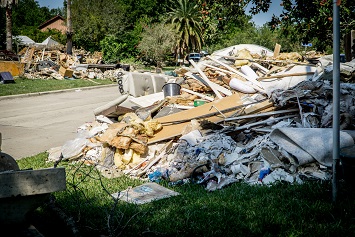After a natural disaster, you may be dealing with a lot of debris at your facility, whether it be generated from damage to the buildings themselves or to the property surrounding them—and cleanup is costly and time consuming. The EPA has reissued its debris guide that places stronger emphasis on pre-incident planning for disaster-related waste management.

Eric Overton / iStock / Getty Images Plus / Getty Images
In 2005, Hurricanes Dennis, Katrina, Rita, and Wilma resulted in $214.8 billion in damage and vast accumulations of debris that had to be managed at a high cost. Removal of 99 million cubic yards of debris from Hurricane Katrina alone cost $3.7 billion. Three years later, in 2008, the EPA published Planning for Natural Disaster Debris, a guide intended to assist communities in preparing for natural disaster debris before the occurrence of events such as hurricanes, earthquakes, tornadoes, volcanoes, floods, wildfires, and winter storms.
Then in 2017, 16 major disasters occurred across the country, resulting in the most expensive year on record for disasters—$306.2 billion in cumulative damages and another immense challenge in postdisaster debris management. The EPA has now reissued its debris guide, incorporating lessons learned since the 2008 version was published. While having a plan in place for debris removal was a part of the 2008 guidance, the revision places even stronger emphasis on pre-incident planning for debris management.
“The primary goal of pre-incident debris management planning should be to prepare the community to manage natural disaster debris effectively in coordination with the whole community (i.e., all governmental, private, nonprofit, community, and other stakeholders),” the guide states. “In addition to helping the community prepare for managing debris generated by natural disasters, pre-incident planning can encompass community resilience, source reduction, and hazard mitigation activities aimed at reducing the amount of time it takes a community to recover, the total amount of debris generated, and the release and exposure to potentially harmful components in the debris.”
A Complex and Labor-Intensive Job
Effective management of debris following a disaster can be a complex undertaking. The long list of tasks a community may face includes estimating debris quantities; assessing debris management options; triaging debris management; segregating debris into different material and wastestreams; identifying debris management sites and facilities and their available capacities; collecting and hauling debris from the field and/or curb; removing debris from waterways and sensitive habitats; sampling and analyzing debris; characterizing debris, including identifying hazardous waste, for proper management; obtaining emergency permits; processing debris (e.g., volume reduction, refrigerant removal, and asbestos removal); packaging and labeling debris for transport; and transporting debris to debris management sites and facilities.
All this can take a long time, even years. But the faster the above and related tasks can be effectively accomplished, the faster the community can return to normal operation. Moreover, the longer it takes to remove debris, the higher the risks of fire, personal injury, and disease.
Each Community Is Different
The guide emphasizes that every disaster is different, as is every community, and each community’s predisaster plan must be sensitive to the types and volumes of debris that can be expected depending on the various disaster scenarios, the existing removal capabilities, other resources that are and are not readily available, the level of assistance than can be obtained from the state and federal government, and other community-specific factors. While recognizing each community’s unique circumstances, the guide offers several general measures that most communities should incorporate into their predisaster plans.
- Consult with key stakeholders and sectors, including transportation, sanitation, emergency response, environmental, agricultural, public health, public works, zoning, and other industry and business leaders.
- Identify potential debris streams, including harmful constituents, and possible quantities that may be generated by a disaster considering the industrial, agricultural, residential, and commercial zones in the community.
- Evaluate existing reuse and recycling programs to determine if they can be scaled up to handle disaster-related wastes.
- Consider waste collection strategies, such as separating the debris into different wastestreams before transporting it off-site.
- Determine locations (or criteria) and capacities for debris management sites that are suitable for debris staging, temporary storage, and decontamination activities.
- Select potential reuse, composting, recycling, treatment, and disposal facilities, including mobile treatment units, that are currently available to the community, state, and region, and assess their daily and long-term capacities.
- Create a debris management-focused community outreach plan.
- Address health and safety considerations for debris management operations (e.g., handling orphaned tanks; animal carcasses; asbestos-containing materials; quarantined materials like pest-infested vegetative debris; and hazardous chemicals from school chemistry labs, medical offices, and hospitals).
“Planning is not an all-or-nothing effort,” states the EPA. “Small but significant steps taken prior to an incident can have a big impact on the efficiency and effectiveness of post-disaster debris management decision-making.”
